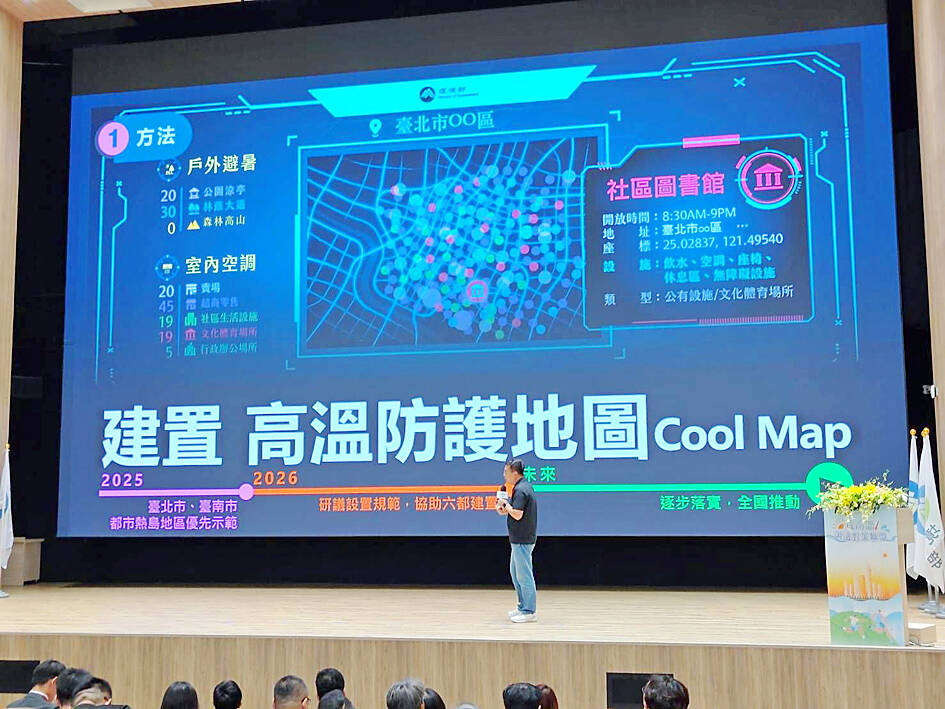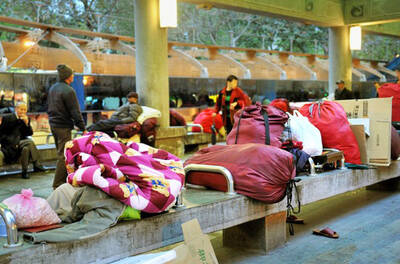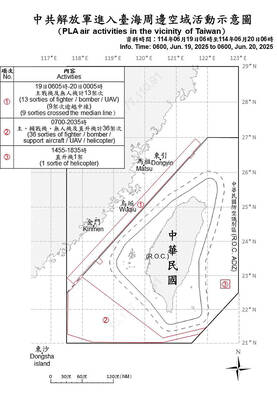The Ministry of Environment yesterday announced the establishment of a public-private alliance focusing on formulating heat adaptation strategies, and jointly developing heat adaptation road maps and mechanisms.
The collaboration would help the Taiwanese public in combating extreme heat and contribute to its overall heat adaptation capacity, the ministry said.
The ministry introduced the alliance composed of government agencies, enterprises and civil groups during a launch ceremony.

Photo: Wu Po-hsuan, Taipei Times
Sixty-three companies — including brick-and-mortar and online retailers, air-conditioning and cooling system providers, transportation services and construction firms — joined the alliance, the ministry said.
The alliance would strive to tackle extreme heat by establishing a heat emergency response mechanism and holding heat adaption drills, Minister of Environment Peng Chi-ming (彭?明) told the ceremony.
It would also work toward developing a national “cool map” for people to find air-conditioned places where they can escape the summer heat, as well as coordinating inter-ministerial data, and pooling the resources of central and local government agencies to address energy poverty.
While there is an emergency response center, which is activated in the event of an emergency, such as typhoons, there is no equivalent for heat waves, Peng said.
The ministry aims to introduce a set of indicators to assess the severity of heat, he said.
The goal is to gradually establish early warning indicators for extreme heat across different sectors and enhance the adaption capacity of vulnerable groups, he added.
Peng said that this year, the Central Weather Administration’s (CWA) “orange” and “red” heat alerts would be used as the activation standard for heat drills, with the aim of gradually implementing a formalized system.
The CWA would issue an orange alert when temperatures top 36°C for three consecutive days, or when maximum temperatures are more than 38°C, and it would issue a red alert when temperatures remain more than 38°C for three consecutive days.
On the issue of heat-related days off, Peng said that the priority should be on enhancing protection measures for businesses and people.
For example, outdoor workers need better equipment to cope with extreme heat, he added.
Extreme heat conditions might only last for a few hours within a single day, making it difficult to justify a full-day “heat holiday,” Deputy Minister of Environment Shih Wen-chen (施文真) said.
The ministry in a statement said that to raise public awareness on heat adaptation, an exhibition would be held from next month to September in northern, central and southern Taiwan.
The exhibition would place special focus on the urban heat island effect in metropolitan areas, aiming to inspire public action to combat urban heat, it said.
The exhibition in the north is scheduled to take place from July 25 to 27 in the lobby of Taipei Mass Rapid Transit System’s Daan Park Station, it said.

A year-long renovation of Taipei’s Bangka Park (艋舺公園) began yesterday, as city workers fenced off the site and cleared out belongings left by homeless residents who had been living there. Despite protests from displaced residents, a city official defended the government’s relocation efforts, saying transitional housing has been offered. The renovation of the park in Taipei’s Wanhua District (萬華), near Longshan Temple (龍山寺), began at 9am yesterday, as about 20 homeless people packed their belongings and left after being asked to move by city personnel. Among them was a 90-year-old woman surnamed Wang (王), who last week said that she had no plans

China might accelerate its strategic actions toward Taiwan, the South China Sea and across the first island chain, after the US officially entered a military conflict with Iran, as Beijing would perceive Washington as incapable of fighting a two-front war, a military expert said yesterday. The US’ ongoing conflict with Iran is not merely an act of retaliation or a “delaying tactic,” but a strategic military campaign aimed at dismantling Tehran’s nuclear capabilities and reshaping the regional order in the Middle East, said National Defense University distinguished adjunct lecturer Holmes Liao (廖宏祥), former McDonnell Douglas Aerospace representative in Taiwan. If

TO BE APPEALED: The environment ministry said coal reduction goals had to be reached within two months, which was against the principle of legitimate expectation The Taipei High Administrative Court on Thursday ruled in favor of the Taichung Environmental Protection Bureau in its administrative litigation against the Ministry of Environment for the rescission of a NT$18 million fine (US$609,570) imposed by the bureau on the Taichung Power Plant in 2019 for alleged excess coal power generation. The bureau in November 2019 revised what it said was a “slip of the pen” in the text of the operating permit granted to the plant — which is run by Taiwan Power Co (Taipower) — in October 2017. The permit originally read: “reduce coal use by 40 percent from Jan.

‘SPEY’ REACTION: Beijing said its Eastern Theater Command ‘organized troops to monitor and guard the entire process’ of a Taiwan Strait transit China sent 74 warplanes toward Taiwan between late Thursday and early yesterday, 61 of which crossed the median line in the Taiwan Strait. It was not clear why so many planes were scrambled, said the Ministry of National Defense, which tabulated the flights. The aircraft were sent in two separate tranches, the ministry said. The Ministry of Foreign Affairs on Thursday “confirmed and welcomed” a transit by the British Royal Navy’s HMS Spey, a River-class offshore patrol vessel, through the Taiwan Strait a day earlier. The ship’s transit “once again [reaffirmed the Strait’s] status as international waters,” the foreign ministry said. “Such transits by